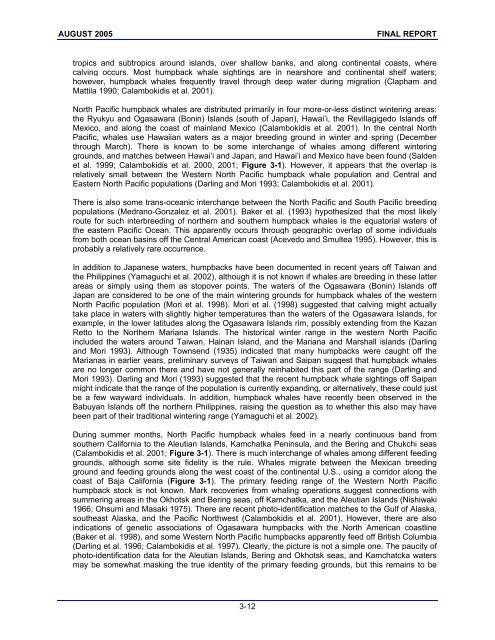Marine Resources Assessment for the Marianas Operating ... - SPREP
Marine Resources Assessment for the Marianas Operating ... - SPREP
Marine Resources Assessment for the Marianas Operating ... - SPREP
Create successful ePaper yourself
Turn your PDF publications into a flip-book with our unique Google optimized e-Paper software.
AUGUST 2005 FINAL REPORT<br />
tropics and subtropics around islands, over shallow banks, and along continental coasts, where<br />
calving occurs. Most humpback whale sightings are in nearshore and continental shelf waters;<br />
however, humpback whales frequently travel through deep water during migration (Clapham and<br />
Mattila 1990; Calambokidis et al. 2001).<br />
North Pacific humpback whales are distributed primarily in four more-or-less distinct wintering areas:<br />
<strong>the</strong> Ryukyu and Ogasawara (Bonin) Islands (south of Japan), Hawai’i, <strong>the</strong> Revillagigedo Islands off<br />
Mexico, and along <strong>the</strong> coast of mainland Mexico (Calambokidis et al. 2001). In <strong>the</strong> central North<br />
Pacific, whales use Hawaiian waters as a major breeding ground in winter and spring (December<br />
through March). There is known to be some interchange of whales among different wintering<br />
grounds, and matches between Hawai’i and Japan, and Hawai’i and Mexico have been found (Salden<br />
et al. 1999; Calambokidis et al. 2000, 2001; Figure 3-1). However, it appears that <strong>the</strong> overlap is<br />
relatively small between <strong>the</strong> Western North Pacific humpback whale population and Central and<br />
Eastern North Pacific populations (Darling and Mori 1993; Calambokidis et al. 2001).<br />
There is also some trans-oceanic interchange between <strong>the</strong> North Pacific and South Pacific breeding<br />
populations (Medrano-Gonzalez et al. 2001). Baker et al. (1993) hypo<strong>the</strong>sized that <strong>the</strong> most likely<br />
route <strong>for</strong> such interbreeding of nor<strong>the</strong>rn and sou<strong>the</strong>rn humpback whales is <strong>the</strong> equatorial waters of<br />
<strong>the</strong> eastern Pacific Ocean. This apparently occurs through geographic overlap of some individuals<br />
from both ocean basins off <strong>the</strong> Central American coast (Acevedo and Smultea 1995). However, this is<br />
probably a relatively rare occurrence.<br />
In addition to Japanese waters, humpbacks have been documented in recent years off Taiwan and<br />
<strong>the</strong> Philippines (Yamaguchi et al. 2002), although it is not known if whales are breeding in <strong>the</strong>se latter<br />
areas or simply using <strong>the</strong>m as stopover points. The waters of <strong>the</strong> Ogasawara (Bonin) Islands off<br />
Japan are considered to be one of <strong>the</strong> main wintering grounds <strong>for</strong> humpback whales of <strong>the</strong> western<br />
North Pacific population (Mori et al. 1998). Mori et al. (1998) suggested that calving might actually<br />
take place in waters with slightly higher temperatures than <strong>the</strong> waters of <strong>the</strong> Ogasawara Islands, <strong>for</strong><br />
example, in <strong>the</strong> lower latitudes along <strong>the</strong> Ogasawara Islands rim, possibly extending from <strong>the</strong> Kazan<br />
Retto to <strong>the</strong> Nor<strong>the</strong>rn Mariana Islands. The historical winter range in <strong>the</strong> western North Pacific<br />
included <strong>the</strong> waters around Taiwan, Hainan Island, and <strong>the</strong> Mariana and Marshall islands (Darling<br />
and Mori 1993). Although Townsend (1935) indicated that many humpbacks were caught off <strong>the</strong><br />
<strong>Marianas</strong> in earlier years, preliminary surveys of Taiwan and Saipan suggest that humpback whales<br />
are no longer common <strong>the</strong>re and have not generally reinhabited this part of <strong>the</strong> range (Darling and<br />
Mori 1993). Darling and Mori (1993) suggested that <strong>the</strong> recent humpback whale sightings off Saipan<br />
might indicate that <strong>the</strong> range of <strong>the</strong> population is currently expanding, or alternatively, <strong>the</strong>se could just<br />
be a few wayward individuals. In addition, humpback whales have recently been observed in <strong>the</strong><br />
Babuyan Islands off <strong>the</strong> nor<strong>the</strong>rn Philippines, raising <strong>the</strong> question as to whe<strong>the</strong>r this also may have<br />
been part of <strong>the</strong>ir traditional wintering range (Yamaguchi et al. 2002).<br />
During summer months, North Pacific humpback whales feed in a nearly continuous band from<br />
sou<strong>the</strong>rn Cali<strong>for</strong>nia to <strong>the</strong> Aleutian Islands, Kamchatka Peninsula, and <strong>the</strong> Bering and Chukchi seas<br />
(Calambokidis et al. 2001; Figure 3-1). There is much interchange of whales among different feeding<br />
grounds, although some site fidelity is <strong>the</strong> rule. Whales migrate between <strong>the</strong> Mexican breeding<br />
ground and feeding grounds along <strong>the</strong> west coast of <strong>the</strong> continental U.S., using a corridor along <strong>the</strong><br />
coast of Baja Cali<strong>for</strong>nia (Figure 3-1). The primary feeding range of <strong>the</strong> Western North Pacific<br />
humpback stock is not known. Mark recoveries from whaling operations suggest connections with<br />
summering areas in <strong>the</strong> Okhotsk and Bering seas, off Kamchatka, and <strong>the</strong> Aleutian Islands (Nishiwaki<br />
1966; Ohsumi and Masaki 1975). There are recent photo-identification matches to <strong>the</strong> Gulf of Alaska,<br />
sou<strong>the</strong>ast Alaska, and <strong>the</strong> Pacific Northwest (Calambokidis et al. 2001). However, <strong>the</strong>re are also<br />
indications of genetic associations of Ogasawara humpbacks with <strong>the</strong> North American coastline<br />
(Baker et al. 1998), and some Western North Pacific humpbacks apparently feed off British Columbia<br />
(Darling et al. 1996; Calambokidis et al. 1997). Clearly, <strong>the</strong> picture is not a simple one. The paucity of<br />
photo-identification data <strong>for</strong> <strong>the</strong> Aleutian Islands, Bering and Okhotsk seas, and Kamchatcka waters<br />
may be somewhat masking <strong>the</strong> true identity of <strong>the</strong> primary feeding grounds, but this remains to be<br />
3-12
















